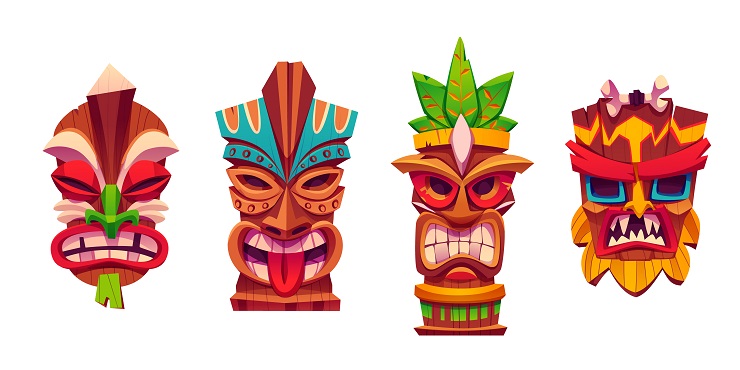
New Zealand is a country known for its stunning landscapes, rich indigenous culture, and diverse population. Beyond its natural beauty and cultural heritage, New Zealand is also home to a variety of superstitions and lucky symbols that reflect the unique blend of influences from the Māori, European settlers, and other cultures that have shaped the nation. These beliefs, whether stemming from ancient traditions or modern practices, play a role in the lives of many New Zealanders, influencing everything from daily routines to significant life events.
1. The Tiki: A Symbol of Good Luck and Protection
One of the most recognizable symbols in New Zealand, especially in Māori culture, is the Tiki. Often carved from greenstone (pounamu), bone, or wood, the Tiki is a stylized human figure that is believed to represent the first human being in Māori mythology. It is often worn as a pendant and is considered a powerful symbol of good luck, fertility, and protection.
The Tiki is thought to bring its wearer good fortune and ward off evil spirits. Traditionally, it was passed down through generations as a treasured family heirloom, carrying the mana (spiritual power) of its previous owners. Today, the Tiki continues to be a popular item of jewelry in New Zealand, valued both for its aesthetic appeal and its cultural significance. The Tiki is also a popular theme in many NZ slots.
2. The Pounamu: New Zealand’s Greenstone
Pounamu, or greenstone, is another significant symbol in New Zealand, particularly in Māori culture. Found mainly in the South Island, this precious stone is considered a taonga (treasure) and is often used to create various items, including pendants, weapons, and tools.
Pounamu is believed to possess strong spiritual qualities, providing protection, strength, and good fortune to its owner. The stone is often given as a gift to mark significant events such as births, marriages, and other important milestones. It is also associated with concepts of endurance and connection to the land, making it a powerful symbol in New Zealand culture.
3. Superstitions in Everyday Life
Like many cultures, New Zealanders have a range of superstitions that influence their daily lives. Some of these are universal, while others have a distinct local flavor:
- Birds as Omens: In New Zealand, birds are often seen as messengers from the spiritual world. The sighting of certain birds, such as the fantail (pīwakawaka), inside a house is traditionally considered an omen of death. However, the interpretation can vary, with some believing that the bird is simply a visitor bringing news from the ancestors.
- Stepping Over Someone: A common Māori superstition is that stepping over someone who is sitting or lying on the ground is disrespectful and can bring bad luck. This act is believed to diminish the mana of the person being stepped over, which is why it is often discouraged.
- Whistling Indoors: Whistling inside a house, particularly at night, is considered bad luck in some New Zealand households. This belief is rooted in the idea that whistling can attract spirits or unwanted presences. Whistling indoors is sometimes avoided even during free demo pokies sessions.
- Cutting Nails at Night: Another superstition shared by many cultures, including some New Zealanders, is the belief that cutting nails at night brings bad luck. This is often avoided to prevent misfortune.
4. Matariki: The Māori New Year
Matariki is a significant event in New Zealand, marking the Māori New Year. It is celebrated when the Matariki star cluster (Pleiades) rises in the sky, usually in late June or early July. Matariki is a time of renewal, reflection, and celebration. It is also a period associated with remembering the deceased, planning for the future, and giving thanks for the harvest.
Many New Zealanders, both Māori and non-Māori, observe Matariki by participating in various cultural activities, including feasts, storytelling, and the sharing of traditional songs and dances. The festival is seen as a time to connect with the land, honor ancestors, and bring communities together, making it a symbol of unity and good fortune for the coming year.
5. Red Socks and the America’s Cup
A more contemporary symbol of good luck in New Zealand is the red socks associated with the America’s Cup. In 1995, Sir Peter Blake, the skipper of Team New Zealand, famously wore a pair of red socks throughout the competition, which his wife had given him as a gift. The socks quickly became a symbol of the team’s success and were adopted by New Zealanders as a lucky charm.
Red socks became a national icon, with many supporters wearing them to show their support for the team. The socks symbolized not only good luck but also the determination, resilience, and teamwork that led to New Zealand’s victory in the prestigious sailing competition.
New Zealand’s lucky symbols and superstitions offer a fascinating glimpse into the country’s cultural fabric, blending Māori traditions with influences from European settlers and other communities. Whether it’s the spiritual power of the Tiki, the significance of Matariki, or the modern-day charm of red socks, these beliefs reflect the unique identity of New Zealand and continue to play an important role in the lives of its people. These symbols and superstitions, passed down through generations, enrich the cultural landscape of New Zealand, adding depth and meaning to the daily lives of its inhabitants.
